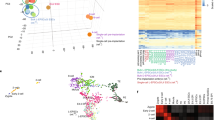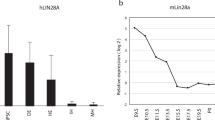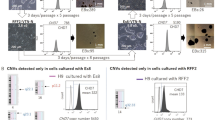Abstract
Characterization of pluripotent stem cells is required for the registration of stem cell lines and allows for an impartial and objective comparison of the results obtained when generating multiple lines. It is therefore crucial to establish specific, fast and reliable protocols to detect the hallmarks of pluripotency. Such protocols should include immunocytochemistry (takes 2 d), identification of the three germ layers in in vitro–derived embryoid bodies by immunocytochemistry (immunodetection takes 3 d) and detection of differentiation markers in in vivo–generated teratomas by immunohistochemistry (differentiation marker detection takes 4 d). Standardization of the immunodetection protocols used ensures minimum variations owing to the source, the animal species, the endogenous fluorescence or the inability to collect large amounts of cells, thereby yielding results as fast as possible without loss of quality. This protocol provides a description of all the immunodetection procedures necessary to characterize mouse and human stem cell lines in different circumstances.
This is a preview of subscription content, access via your institution
Access options
Subscribe to this journal
Receive 12 print issues and online access
$259.00 per year
only $21.58 per issue
Buy this article
- Purchase on Springer Link
- Instant access to full article PDF
Prices may be subject to local taxes which are calculated during checkout













Similar content being viewed by others
References
Evans, M.J. & Kaufman, M.H. Establishment in culture of pluripotential cells from mouse embryos. Nature 292, 154–156 (1981).
Thomson, J.A. et al. Embryonic stem cells lines derived from human blastocysts. Science 282, 1145–1147 (1998).
Takahashi, K. & Yamanaka, S. Induction of pluripotent stem cells from mouse embryonic and adult fibroblast cultures by defined factors. Cell 126, 663–676 (2006).
Takahashi, K. et al. Induction of pluripotent stem cells from adult human fibroblast by defined factors. Cell 131, 861–872 (2007).
Carpenter, M.K. & Bhatia, M. Characterization of human embryonic stem cells. in Handbook of Stem Cells, Vol 1: Embryonic stem cells (eds. Lanza, R. et al.) 407–411 (Elsevier/Academic Press, 2004).
Ohnuki, M., Takahashi, K. & Yamanaka, S. Generation and characterization of human induced Pluripotent stem cells. Curr. Protoc. Stem Cell Biol. 9, 4A.2.1–4A.2.25 (2009).
Crook, J.M., Hei, D. & Stacey, G. International Stem Cell Banking Initiative: raising standards to bank on. In Vitro Cell Dev. Biol. Anim. 46, 169–172 (2010).
Adewumi, O. et al. Characterization of human embryonic stem cell lines by the international stem cell initiative. Nat. Biotechnol. 25, 803–815 (2007).
Neale, F., Clubb, J.S., Hotchks, D. & Posen, S. Heat stability of human placental alkaline phosphatase. J. Clin. Pathol. 18, 359–363 (1965).
Henthorn, P., Zervos, P., Raducha, M., Harris, H. & Kadesch, T. Expression of a human placental alkaline phosphatase gene in transfected cells: use as a reporter for studies of gene expression. Proc. Natl. Acad. Sci. USA 85, 6342–6346 (1988).
Maatman, R. et al. Aggregation of embryos and embryonic stem cells. Transgenic mouse. Methods Mol. Biol. 209, 201–230 (2002).
Wang, J., Levasseur, D.N. & Orkin, S.H. Requirement of Nanog dimerization for stem cell self-renewal and pluripotency. Proc. Natl. Acad. Sci. USA 105, 6326–6331.
Das, S., Jena, S. & Levasseur, D.N. Alternative splicing produces Nanog protein variants with different capacities for self-renewal and pluripotency in embryonic stem cells. J. Biol. Chem. 286, 42690–42703 (2011).
Cauffman, G., Van de Velde, H., Liebaers, I. & Van Steirteghem, A. Oct-4 mPNA and protein expression during human preimplantation development. Mol. Hum. Reprod. 11, 173–181 (2005).
Cauffman, G., Liebaers, I., Van Steirteghem, A. & Van de Velde, H. POU5F1 isoforms show different expression patterns in human embryonic stem cells and preimplantation embryos. Stem Cells 24, 2685–2691 (2006).
Müller, F.J. et al. A bioinformatic assay for pluripotency in human cells. Nat. Methods 8, 315–317 (2011).
Hentze, H. et al. Teratoma formation by human embryonic stem cells: evaluation of essential parameters for future safety studies. Stem Cell Res. 3, 198–210 (2009).
Itskovitz-Eldor, J. et al. Differentiation of human embryonic stem cells into embryoid bodies compromising the three embryonic germ layers. Mol. Med. 6, 88–95 (2000).
Aasen, T. et al. Efficient and rapid generation of induced pluripotent stem cells from human keratinocytes. Nat. Biotechnol. 26, 1276–1284 (2008).
Aran, B. et al. Derivation of human embryonic stem cells at the Center of Regenerative Medicine in Barcelona. In vitro Cell Dev. Biol. Anim. 46, 356–366 (2010).
Keller, G.M. In vitro differentiation of embryonic stem cells. Curr. Opin. Cell Biol. 7, 862–869 (1995).
Cerdan, C., Hong, S.H. & Bhatia, M. Formation and hematopoietic differentiation of human embryoid bodies by suspension and hanging drop cultures. Curr. Protoc. Stem Cell Biol. 3, 1D.2.1–1D.2.16 (2007).
Sundström, J. et al. Characterization of the model for experimental testicular teratoma in 129/SvJ-mice. Br. J. Cancer 80, 149–160 (1999).
Gertow, K. et al. Isolation of human embryonic stem cell–derived teratomas for the assessment of pluripotency. Curr. Protoc. Stem Cell Biol. 3, 1B.4.1–1B.4.29 (2007).
Campos, P.B., Sartore, R.C., Abdalla, S.N. & Rehen, S.K. Chromosomal spread preparation of human embryonic stem cells for karyotyping. J. Vis. Exp. 31, e1512 (2009).
Schröck, E. et al. Multicolor spectral karyotyping of human chromosomes. Science 273, 494–497 (1996).
Gonzalez, F. et al. Generation of mouse induced pluripotent stem cells by transient expression of a single non-viral polycistronic vector. Proc. Natl. Acad. Sci. USA 106, 8918–8922 (2009).
Raya, A. et al. Disease-corrected haematopoietic progenitors from Fanconi anaemia induced pluripotent stem cells. Nature 460, 53–59 (2009).
Kawamura, T. et al. Linking the p53 tumor suppressor pathway to somatic cell reprogramming. Nature 460, 1140–1144 (2009).
Giorgetti, A. et al. Generation of induced pluripotent stem cells from cord blood using OCT4 and SOX2. Cell Stem Cell 5, 353–357 (2009).
Montserrat, N. et al. Generation of feeder free pig induced pluripotent stem cells without Pou5f1. Cell Transplant. 21, 815–825 (2011).
Acknowledgements
We are grateful to all the researchers who provided us their samples to be analyzed, with special mention to I. Rodriguez, A. Giorgietti, A. Consiglio, R. Vassena, N. Montserrat, C. Eguizabal and S. Menendez. Work in the laboratory of J.C.I.B. was supported by grants from TERCEL-ISCII-MINECO, CIBER, Fundacion Cellex, Sanofi, The Leona M. and Harry B. Helmsley Charitable Trust and the G. Harold and Leila Y. Mathers Charitable Foundation.
Author information
Authors and Affiliations
Contributions
All authors contributed equally to this work. M.M. designed the protocols, analyzed the data and wrote the paper; L.M. and C.P. performed and optimized the protocols; C.M. contributed to the microscope observations, live-cell staining and flow cytometry analysis; M.C. performed cell cultures and EB formation, and helped with the manuscript; L.L.-R. helped with the manuscript and gave conceptual advice; C.R.E. performed and optimized the protocols; and J.C.I.B. supervised the project and wrote the manuscript.
Corresponding author
Ethics declarations
Competing interests
The authors declare no competing financial interests.
Supplementary information
Supplementary Figure 1
Alkaline phosphatase staining. Flow chart showing steps 1 to 9 of the protocol. Timing: 30 min. (PDF 295 kb)
Supplementary Figure 2
Pluripotency detection. Flow chart showing Steps 10 to 37 of the protocol. Timing: 2 days. (PDF 315 kb)
Supplementary Figure 3
Differentiation detection in EBs in suspension (OPTION A). Flow chart showing steps 38 A/I to XVI of the protocol. Timing: 5 days. (PDF 299 kb)
Supplementary Figure 4
Differentiation detection in EBs over SlideFlask (OPTION B). Flow chart showing steps 38 B/ I to XVIII. Timing: 3 days. (PDF 325 kb)
Supplementary Figure 5
Differentiation detection in teratomas (OPTION A). Flow chart showing steps 44 A/ I to XXV of the protocol. Timing: 5 days. (PDF 328 kb)
Supplementary Figure 6
Cell proliferation in teratomas (OPTION B). Flow chart showing steps 44 B/ I to XXVII. Timing: 6-8 days. (PDF 376 kb)
Supplementary Figure 7
Proliferation versus apoptosis in teratomas (OPTION C). Flow chart showing steps 44C /I to XXIX. Timing: 3 days. (PDF 178 kb)
Supplementary Video 1
Time lapse obtained from 15 h of a colony staining with Tra-1-81. Merge images of the green fluorescence and the transmitted light image. Image information: Inverted microscope: Leica DMI4000. Image pixels: 1024 x 1024. Resolution: 8 bits. Image: xyt series. Scale Bar: 75 μm. (MPG 2600 kb)
Supplementary Video 2
Time lapse obtained from 15 h of a colony staining with Tra-1-81, showing only the green fluorescence of the previous video. Image information: Inverted microscope: Leica DMI4000. Image pixels: 1024 x 1024. Resolution: 8 bits. Image: xyt series. Scale Bar: 75 μm. (MPG 706 kb)
Rights and permissions
About this article
Cite this article
Martí, M., Mulero, L., Pardo, C. et al. Characterization of pluripotent stem cells. Nat Protoc 8, 223–253 (2013). https://doi.org/10.1038/nprot.2012.154
Published:
Issue Date:
DOI: https://doi.org/10.1038/nprot.2012.154
This article is cited by
-
Generation of a bank of clinical-grade, HLA-homozygous iPSC lines with high coverage of the Spanish population
Stem Cell Research & Therapy (2023)
-
Optimization of differential filtration-based mitochondrial isolation for mitochondrial transplant to cerebral organoids
Stem Cell Research & Therapy (2023)
-
Characterization of mitochondrial health from human peripheral blood mononuclear cells to cerebral organoids derived from induced pluripotent stem cells
Scientific Reports (2021)
-
Stem-cell-derived human microglia transplanted into mouse brain to study human disease
Nature Protocols (2021)
-
The use of induced pluripotent stem cells in domestic animals: a narrative review
BMC Veterinary Research (2020)
Comments
By submitting a comment you agree to abide by our Terms and Community Guidelines. If you find something abusive or that does not comply with our terms or guidelines please flag it as inappropriate.



